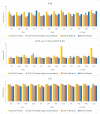Effects of Dispersant on the Petroleum Hydrocarbon Biodegradation and Microbial Communities in Seawater from the Baltic Sea and Norwegian Sea
- PMID: 37110305
- PMCID: PMC10142239
- DOI: 10.3390/microorganisms11040882
Effects of Dispersant on the Petroleum Hydrocarbon Biodegradation and Microbial Communities in Seawater from the Baltic Sea and Norwegian Sea
Abstract
Dispersants have been used in several oil spill accidents, but little information is available on their effectiveness in Baltic Sea conditions with low salinity and cold seawater. This study investigated the effects of dispersant use on petroleum hydrocarbon biodegradation rates and bacterial community structures. Microcosm experiments were conducted at 5 °C for 12 days with North Sea crude oil and dispersant Finasol 51 with open sea Gulf of Bothnia and coastal Gulf of Finland and Norwegian Sea seawater. Petroleum hydrocarbon concentrations were analysed with GC-FID. Bacterial community structures were studied using 16S rDNA gene amplicon sequencing, and the abundance of genes involved in hydrocarbon degradation with quantitative PCR. The highest oil degradation gene abundances and oil removal were observed in microcosms with coastal seawater from the Gulf of Bothnia and Gulf of Finland, respectively, and the lowest in the seawater from the Norwegian Sea. Dispersant usage caused apparent effects on bacterial communities in all treatments; however, the dispersant's effect on the biodegradation rate was unclear due to uncertainties with chemical analysis and variation in oil concentrations used in the experiments.
Keywords: Baltic Sea; Norwegian Sea; bacterial community; dispersant; oil biodegradation; oil spill.
Conflict of interest statement
The authors declare no conflict of interest.
Figures











References
-
- HELCOM . Baltic Sea Environment Proceedings No. 152. Helsinki Commission; Helsinki, Finland: 2018. HELCOM Assessment on maritime activities in the Baltic Sea 2018.
-
- Lehto H., Venäläinen P., Hietala K. Growth Outlook of Seaborne Transport between Finland and Foreign Countries up to 2030. Finnish Maritime Administration Publications; Helsinki, Finland: 2006.
-
- Lessard R.R., De Marco G. The Significance of Oil Spill Dispersants. Spill Sci. Technol. Bull. 2000;6:59–68. doi: 10.1016/S1353-2561(99)00061-4. - DOI
-
- Allen T. National Incident Commander’s Report: MC252 Deepwater Horizon. National Incident Command; Washington, DC, USA: 2010.
Grants and funding
LinkOut - more resources
Full Text Sources
Miscellaneous

